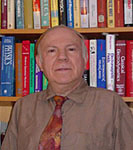
PHYSICS 102 - INTRODUCTION TO PHYSICS II |
Professor: Walerian Majewski |
 |
PHY 102 is a college-level course intended for students with non-technical majors who need a science lab & course. Students will gain an understanding of the physical principles involved in their everyday environment. The course will serve as an alternative physics course for those students having little or no algebra math skills. It is a continuation of a first-semester analog Introduction to Physics I - a distance learning course PHY 101. ELI NVCC has also two other physics sequences: algebra-based PHY 201,202 General College Physics I, II for pre-med, pre-vet, pre-dental, Liberal Arts and pre-teaching non-science majors, and calculus-based PHY 231, 232 General University Physics I, II for engineering, science and mathematics majors. This course surveys general principles of physics. They include topics such as sound, light, electricity and magnetism, and modern physics. It involves using arithmetic and some simple algebra, mostly in laboratory. This course requires reliable fast Internet access and attendance at three laboratory experiments and problem-solving practice on Saturdays: Jan 16, Jan 23 and Jan 30 at 2-7 pm, CS 247, Annandale campus. |
||||||||||||||||||||||||||||||||||||||||||||||||||
| Top | |||||||||||||||||||||||||||||||||||||||||||||||||||
electricity, magnetism, optics, and wave physics. Specifically, you will learn to * calculate electric forces and electric fields from charges. * calculate electric potential from charge distributions or from the electric field. * calculate capacitance and resistance of arrangements of conducting materials. * use Kirchoff's Laws to find characteristics of dc circuits. * calculate magnetic forces and magnetic fields. * understand magnetic induction and to use Lenz's and Faraday's Laws. * calculate characteristics of ac circuits. * understand the nature of electromagnetic waves and light *understand phenomena and laws of geometric and wave optics, such as reflection, refraction, polarization, interference * calculate effects in geometric and wave optics, including interaction of light with optical elements such as lenses, mirrors, * describe traveling and standing wave patterns of mechanical waves, understand and calculate sound effects such as intensity, loudness, pitch, beats, Doppler effect. In the laboratory you will learn to: * take accurate measurements with confidence and understand the uncertainties *associated with them and uncertainty propagation, calculate percent error and percent difference * use computer-assisted laboratory methods, based on ScienceWorkshop interface * analyze data using graphical and computer-based techniques. * spread-sheet style analysis of data and computer plots * analyze data to induce scientific conclusions * write meaningful conclusions based on observations, calculations, and data analysis * collaborate with others as a team to produce collective results * construct simple circuits with resistors, capacitors, and inductors |
|||||||||||||||||||||||||||||||||||||||||||||||||||
| Top | |||||||||||||||||||||||||||||||||||||||||||||||||||
In this course instead of the usual paper textbook you will use an innovative comprehensive digital physics textbook on a CD, to be downloaded on your computer and enabling you to experience physics as never before. It presents physics with text and diagrams supplemented with thousands of narrated animations. Hundreds of simulations and interactive problems will challenge you to apply and assess what they are learning.
You have to install them on your home computer (only one installation permitted) and use the book CD for study and the lab CD to do laboratory simulations. For information on how to order your textbooks, go to http://eli.nvcc.edu/books/ |
|||||||||||||||||||||||||||||||||||||||||||||||||||
| Top | |||||||||||||||||||||||||||||||||||||||||||||||||||
| Grading | |||||||||||||||||||||||||||||||||||||||||||||||||||
Your final grade will be based on the following scale. Please note that you must also pass at least 3 of the exams in order to pass the course, regardless of your scores on the other assignments.
Top |
|
| |
For Testing Center locations, hours of operation and policies, click here. For information on taking exams outside of the metropolitan area, click here. Top |
|
| |
This is an Extended Learning Institute (ELI) course. ELI courses differ from campus courses in several important ways, including enrollment dates, communication with faculty, assignment completion requirements, and exams. You must follow ELI's policies and procedures if you take this course. Read (or review) ELI's Policies and Procedures before you begin the course. If you have questions, call ELI at (703) 323-3347 or (888) 435-6822. Top |
|
| |
E-mail : wmajewski@nvcc.edu Top |
|
| |
Please note that account generation takes approximately one week from the time of your paid registration. If you cannot log on after one week, contact the IT Help Desk. If you can log on to Blackboard, but your course isn't listed, please contact ELI or your instructor.
|
| ||||||||||||||||||||||||||||||||||